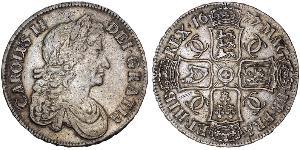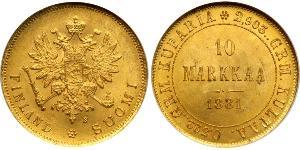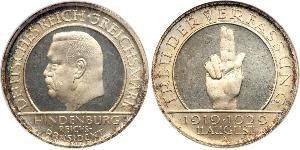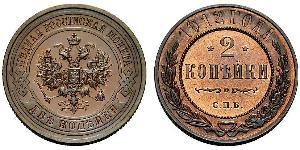(sold for $55.0)
1846, French Guiana, Louis-Philippe. Colonial Billon Silver 10 Centimes Coin. aXF!
Mint Year: 1818
Mint Place: Paris (A)
Reference: KM-A2. R!
Denomination: 10 Centimes
Condition: Minor deposits, otherwise about XF!
Material: Billon Silver (low grade silver & bronze alloy)
Diameter: 22mm
Weight: 2.47gm
Obverse: Denomination (10 CENT.), privy mark (Cock), mint initial (A) and engraver´s signature (BARRE).
Legend: GUYANNE FRANCAISE 1846
Reverse: Crowned monogram of Louis-Philippe.
Legend: LOUIS PHILIPPE I ROI DES FRANCAISE
French Guiana is an overseas region of France, consisting of a single overseas department located on the northern Atlantic coast of South America. It has borders with two nations: Brazil to the east and south, and Suriname to the west. French Guiana was originally inhabited by a number of indigenous American people. It was settled by the French during the 18th century. According to Bill Marshall, "The first French effort to colonize Guiana, in 1763, failed utterly when tropical diseases and climate killed all but 2,000 of the initial 12,000 settlers. […] During its existence, France transported approximately 56,000 prisoners to Devil's Island. Fewer than 10 percent survived their sentence." Its infamous Île du Diable (Devil's Island) was the site of penal settlements from 1852 until 1951. In 1809, a Portuguese-British naval squadron took French Guiana for the Portuguese Empire. With the signing of the Treaty of Paris in 1814 the region was handed back to the French, though a Portuguese presence remained until 1817. A border dispute with Brazil arose in the late 19th century over a vast area of jungle, leading to the short-lived pro-French independent state of Counani in the disputed territory and some fighting between settlers, before the dispute was resolved largely in favour of Brazil by the arbitration of the Swiss government. In 1946, French Guiana became an overseas department of France.
Louis-Philippe (6 October 1773 – 26 August 1850), was King of the French from 1830 to 1848 in what was known as the July Monarchy. He was the last king to rule France, although Napoleon III, styled as an emperor, would serve as its last monarch.
Louis Philippe d'Orléans was born at the Palais Royal in Paris to Louis Philippe Joseph, Duke of Chartres (later Duke of Orléans and, later still, known as Philippe Egalité) and Louise Marie Adélaïde de Bourbon-Penthièvre. As a member of the reigning House of Bourbon, he was a Prince du Sang. He was the first of three sons and a daughter of the Orléans family, a family that was to have erratic fortunes for the next court years.
In 1830, the July Revolution overthrew Charles X. Charles abdicated in favor of his 10-year-old grandson, Henri, Duke of Bordeaux. Louis Philippe was charged by Charles X to announce to the popularly elected Chamber of Deputies his desire to have his grandson succeed him. Louis Philippe did not do this, in order to increase his own chances of succession. As a consequence, because the chamber was aware of Louis Philippe's Liberal policies and his popularity with the masses, they proclaimed Louis Philippe, who for 11 days had been acting as the regent for his small cousin, as the new French king, displacing the senior branch of the House of Bourbon.
In anger over this betrayal, Charles X and his family, including his grandson, left for Great Britain. The grandson, better known as the Henri, Comte de Chambord, later became the pretender to Louis Philippe's throne and was supported by many nobles known as Legitimists.
Upon accession, Louis Philippe assumed the title of King of the French - a title already employed in the short-lived Constitution of 1791. Linking the monarchy to a people instead of a territory (as the previous designation King of France and Navarra) aimed at undercutting the Legitimist claims of Charles X and his family.
By his ordinance of 13 August 1830, soon after his accession to the throne, it was decided that the king's sister and his children would continue to bear the arms of Orléans, that Louis Philippe's eldest son, as Prince Royal, would bear the title Duke of Orléans, that the younger sons would continue to have their previous titles, and that the sister and daughters of the king would only be styled Princesses of Orléans, not of France.
In 1832, his daughter, Princess Louise-Marie (1812–1850), married the first ruler of Belgium, Leopold I, King of the Belgians.
In July 1835 Louis Philippe survived an assassination attempt by Giuseppe Mario Fieschi on the boulevard du Temple in Paris.
In 1831, his son and heir, Ferdinand Philippe, Duke of Orléans, died in a carriage accident.
Louis Phillippe ruled in an unpretentious fashion, avoiding the pomp and lavish spending of his predecessors. Despite this outward appearance of simplicity, his support came from the wealthy middle classes. At first, he was much loved and called the "Citizen King" and the "bourgeois monarch," but his popularity suffered as his government was perceived as increasingly conservative and monarchical, despite his return of Napoleon's remains to France. Under his management the conditions of the working classes deteriorated, and the income gap widened considerably. An economic crisis in 1847 led to the citizens of France revolting against their king again the following year.
On 24 February 1848, during the February 1848 Revolution, to general surprise, King Louis Philippe abdicated in favor of his nine-year-old grandson, Philippe. Fearful of what had happened to Louis XVI, Louis Philippe quickly disguised himself and fled Paris. Riding in an ordinary cab under the name of "Mr. Smith", he escaped to England. According to The Times of 6 March 1848, the King and Queen were received at Newhaven, East Sussex before travelling by train to London.
The National Assembly initially planned to accept young Philippe as king, but the strong current of public opinion rejected that. On 26 February, the Second Republic was proclaimed. Prince Louis Napoleon Bonaparte was elected President in December; a few years later he declared himself president for life and then Emperor Napoleon III.
Louis Philippe and his family lived in England until his death in Claremont, Surrey. He is buried with his wife, Amelia (26 April 1782–24 March 1866), at the Chapelle royale de Dreux, the family necropolis his mother had built in 1816, in Dreux.
Only 1$ shipping for each additional coin purchased!

|
Posted by:
anonymous 2016-07-19 |
1 Pagoda India Gold
group has 2 coins / 1 prices
⇑
50 Ban Kingdom of Romania (1881-1947) Silver Carol I of Roma ...
group has 4 coins / 3 prices
⇑

















-300-150-iK8Kbzbi7sQAAAFP85RtcWcj.jpg)






